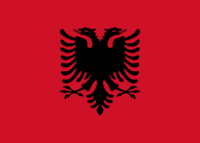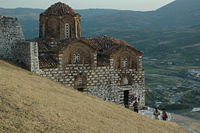Albania: Difference between revisions
imported>Eddie Ortiz Nieves (added full citations) |
imported>Domergue Sumien (copyedit) |
||
| Line 1: | Line 1: | ||
{{subpages}} | {{subpages}} | ||
[[Image:Flag of Albania.png|thumb|right|200px|The flag of Albania. {{PD-anon-image}}]] | [[Image:Flag of Albania.png|thumb|right|200px|The flag of Albania. {{PD-anon-image}}]] | ||
'''Albania''', officially the '''Republic of Albania''' (Albanian: ''Republika e Shqipërisë'', IPA [ɾɛˈpubliˌka ɛ ˌʃcipəˈɾiːs]), is a [[country]] in [[Europe]]. Its [[ | '''Albania''', officially the '''Republic of Albania''' (Albanian: ''Shqipëria, Republika e Shqipërisë'', IPA [ɾɛˈpubliˌka ɛ ˌʃcipəˈɾiːs]), is a [[country]] in [[Europe]]. Its capital is [[Tirana]]. It was a part of the [[Ottoman Empire]] until it gained its independence in 1912. After [[World War II]], [[Communism]] ruled in the country until 1991, when it officially established a multi-party [[democracy|democratic]] [[government]]. | ||
==Divisions== | ==Divisions== | ||
[[Image:Albanian Church.jpg|right|thumb|200px|A Byzantine Church in Berat. {{CC-photo|Jason Rogers}}]] | [[Image:Albanian Church.jpg|right|thumb|200px|A Byzantine Church in Berat. {{CC-photo|Jason Rogers}}]] | ||
Revision as of 02:36, 26 October 2008

Albania, officially the Republic of Albania (Albanian: Shqipëria, Republika e Shqipërisë, IPA [ɾɛˈpubliˌka ɛ ˌʃcipəˈɾiːs]), is a country in Europe. Its capital is Tirana. It was a part of the Ottoman Empire until it gained its independence in 1912. After World War II, Communism ruled in the country until 1991, when it officially established a multi-party democratic government.
Divisions

Albania is divided into qarqe or counties. There are twelve counties in Albania. These include Berat, Dibër, Durrës, Elbasan, Fier, Gjirokastër, Kukës, Shkodër, Tirana, and Vlorë. These counties are subdivided into 36 rrethe or districts. [1]
Geography
Albania has 28,748 total mi² of territory. [2] It is the 151th largest country in the world. [3] It is bordered by the Adriatic and Ionian Seas, Greece to the south, and Montenegro and Serbia to the north. [2] The countrie's average annual temperature is of 7ºC and receives an average annual rainfall of 1,000 mL of water. [4] Its highest point is the Maja e Korabit or Golem Korab, which rises 2,764 m above sea level. Its terrain is mostly composed of mountains and hills, with some small plains along its coast. [2]
Demography
Albania has a total population of 3,600,523 people, as of a 2007 estimate. [5] It is the 131th most populated country in the world. The nationality is called Albanian. Major ethnic groups include Albanians, which make up 95% of the population, Greeks, which make up 3% of the population, and others, like Vlach, Gypsy, Serb, Macedonian, and Bulgarian, which make up 2% of the population. [6] The major religions practiced in the country are Islam, Roman Catholicism, and Albanian Orthodoxy. [7] Languages spoken in Albania include Albanian (official), Greek, Vlach, Romani, and Slavic dialects. [8]
References
- ↑ Administrative Divisions of Countries ("Statoids"). Counties of Albania. Retreived on October 21, 2007.
- ↑ 2.0 2.1 2.2 Central Intelligence Agency: The World Factbook. Angola. Retreived on October 21, 2007.
- ↑ Central Intelligence Agency: The World Factbook. Rank Order - Area. Retreived on October 21, 2007.
- ↑ South Travels. Weather & Climate in Albania. Retreived on October 21, 2007.
- ↑ Country Reports. Albania Country Information. Retreived on October 21, 2007.
- ↑ CrescentLife. Ethnic Groups, Religions & Languages of various Islamic Countries. Retreived on October 21, 2007.
- ↑ Country Studies. Albania: Religion. Retrieved from the United States Library of Congress on October 21, 2007.
- ↑ Gordon, Raymond G., Jr. (2005). Ethnologue: Languages of the World, Fifteenth edition. (SIL International; Online version) Languages of Albania. Retreived on October 21, 2007.